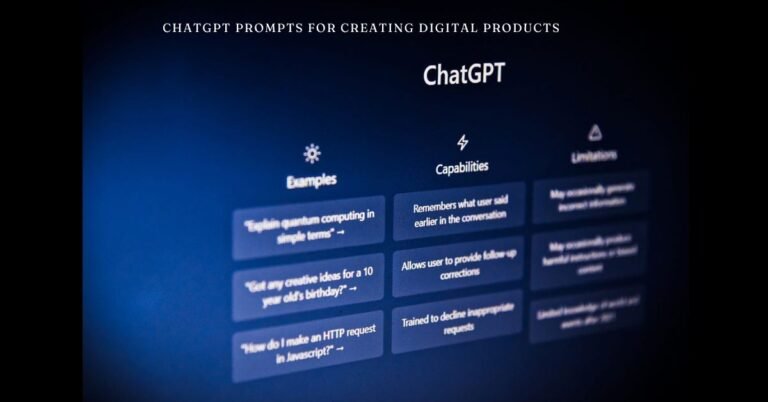The digital era has revolutionized how creators bring their ideas to life, and ChatGPT has emerged as a groundbreaking tool in this landscape. Leveraging the right prompts, you can streamline the process of developing high-quality digital products, from eBooks and templates to courses and apps. This guide will walk you through practical and innovative ways to use chatgpt prompts for creating digital products.
Why Use ChatGPT for Digital Product Creation?
Creating digital products traditionally required significant time, effort, and resources. However, ChatGPT simplifies this process by serving as a versatile assistant. It can ideate, draft, and refine your projects, cutting down production times and enhancing creativity. For instance, it can generate comprehensive outlines for an eBook, craft marketing strategies, or even suggest features for a mobile application. Its versatility makes it an indispensable resource for creators seeking to innovate and scale their offerings.
One key advantage of using chatgpt prompts for creating digital products is its ability to cater to specific niches. Whether you’re creating templates for educators, a course for budding entrepreneurs, or even a graphic design portfolio, ChatGPT’s tailored prompts can help you develop products that resonate with your target audience. The tool also ensures that your ideas remain fresh and aligned with current market trends, making it a cost-effective solution for creators.
Generating Ideas for Digital Products
The foundation of any successful digital product is a strong idea. ChatGPT excels in generating concepts tailored to your interests and goals. By providing clear and specific prompts, you can unlock unique ideas that cater to various industries.
For example, asking ChatGPT to suggest trending eBook topics for 2025 might yield results like “The Future of Remote Work,” “Sustainable Living Practices,” or “AI-Driven Marketing Strategies.” If you’re looking to create an online course, you could refine your request further by specifying the subject, such as “Beginner’s Guide to Personal Finance” or “Mastering Digital Illustration.” By layering your prompts with additional details, you can ensure that the results are aligned with your vision.
This phase of idea generation isn’t just limited to text-based products. If you’re planning to create software, ChatGPT can provide insights into potential features, user pain points, or even monetization strategies. For instance, you might prompt the tool with, “Suggest innovative features for a productivity app designed for remote teams,” and it could respond with ideas like time-blocking functions, real-time collaboration boards, and integrations with project management tools.
Structuring and Outlining Content
Once you’ve settled on an idea, the next step is to outline your digital product. ChatGPT’s ability to break down complex tasks into manageable steps makes it invaluable in this phase. By using prompts such as, “Create an outline for a six-module course on graphic design,” you can quickly develop a structured framework that includes key topics and subtopics.
For example, an outline for a graphic design course might include:
- Introduction to Graphic Design: History, tools, and fundamental concepts.
- Principles of Design: Typography, color theory, and visual hierarchy.
- Software Tutorials: Hands-on lessons in Adobe Illustrator, Photoshop, and Canva.
- Project-Based Learning: Creating logos, posters, and social media graphics.
- Portfolio Development: Tips for assembling and presenting your work.
- Freelancing Essentials: Building a client base and setting competitive rates.
These outlines not only provide a clear roadmap for content creation but also ensure that all necessary components are covered, enhancing the product’s overall quality and value.
Drafting Content and Templates
Content creation is often the most time-intensive part of digital product development. ChatGPT can accelerate this process by generating high-quality drafts based on your specifications. For instance, if you’re writing an eBook, you could use a prompt like, “Draft a 500-word introduction for an eBook on sustainable living.” ChatGPT’s response will typically include well-structured and engaging content that you can refine further.
Templates are another area where ChatGPT shines. Whether you’re designing a social media calendar, a business plan template, or a lesson plan for educators, prompts like “Create a project management template for small teams” can yield ready-to-use formats. These templates can save you hours of work while ensuring that your product meets professional standards.
Refining and Polishing Your Work
Creating a polished final product requires multiple iterations, and ChatGPT can assist with each revision. Use prompts such as, “Edit this paragraph to make it more concise,” or “Rewrite this text in a more professional tone.” The tool can also help simplify complex ideas for a broader audience, making your product more accessible.
For example, if you’re working on a technical guide, you might prompt ChatGPT with, “Explain blockchain technology in simple terms suitable for beginners.” Its ability to adapt its tone and language ensures that your content is both engaging and easy to understand.
Advanced Applications: Marketing and Beyond
Once your digital product is ready, the next challenge is marketing it effectively. ChatGPT can assist in crafting compelling ad copy, email campaigns, and social media posts. For instance, you could prompt it with, “Write a Facebook ad for a new productivity planner,” or “Create an email sequence for launching an online course.”
Moreover, ChatGPT can help with SEO optimization by generating keyword-rich meta descriptions, blog post outlines, and article drafts. Prompts like, “Generate a 1,000-word blog post on effective email marketing strategies,” can provide you with a solid starting point for content marketing efforts.
Visual Enhancements: Infographics and Charts
Incorporating visuals like infographics or charts into your digital products can significantly enhance their appeal and usability. While ChatGPT cannot directly create visuals, it can suggest structures and ideas. For example, you might prompt it with, “Outline the data points for an infographic on the benefits of remote work.” These suggestions can then be handed off to a graphic design tool or professional.
Common Challenges and How to Address Them
Using ChatGPT for digital product creation isn’t without its challenges. One common issue is receiving overly generic responses. To address this, ensure that your prompts are specific and detailed. For example, instead of asking, “Suggest blog topics,” you could specify, “Suggest blog topics on AI applications in education.”
Another challenge is maintaining originality. While ChatGPT is an excellent starting point, it’s essential to add your unique voice and insights to the content. Using plagiarism checkers and infusing personal anecdotes or expertise can further differentiate your product.
Conclusion
Using “ChatGPT prompts for creating digital products” can transform your creative process, making it faster, more efficient, and highly effective. From ideation to marketing, ChatGPT serves as a versatile assistant, empowering creators to develop high-quality products that stand out in a competitive market. By experimenting with tailored prompts and refining the tool’s outputs, you can unlock new levels of productivity and innovation. Whether you’re a seasoned entrepreneur or a beginner exploring digital creation, ChatGPT is a game-changing resource that can help you achieve your goals.
FAQs
1. Can ChatGPT create an entire digital product independently?
No, while ChatGPT can assist with ideation, drafting, and refinement, human input is essential for quality control, creativity, and final execution.
2. How do I ensure that my ChatGPT-generated content is unique?
Always personalize the output with your voice and expertise. Use plagiarism detection tools to verify originality.
3. What types of digital products are ideal for ChatGPT assistance?
EBooks, online courses, templates, marketing materials, and software concepts are all well-suited for ChatGPT support.
4. How can I use ChatGPT to market my digital products?
ChatGPT can create ad copy, email sequences, blog posts, and SEO strategies tailored to your audience.
5. Is ChatGPT a cost-effective solution for small businesses?
Yes, by reducing reliance on multiple specialists, ChatGPT offers a budget-friendly way to streamline the creation and marketing of digital products.

